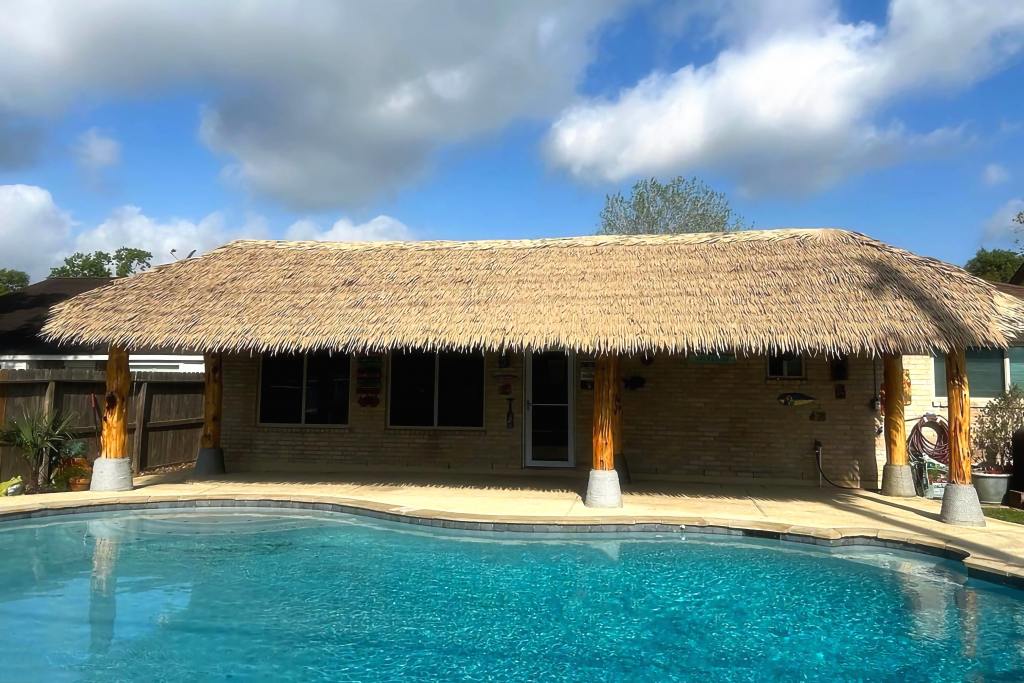Synthetic Building Materials 2024: A Revolution in Construction Interiors and Exterior Design
Introduction
In the realm of home construction, a quiet revolution has been unfolding, reshaping the very fabric of our dwellings. Gone are the days of traditional building materials, replaced by the era of Synthetic Thatch, Synthetic Bamboo, and other innovative synthetic building products. In this article, we’ll explore the transformative impact of these materials on home exteriors, siding, and trim, unveiling their unique features and the profound benefits they bring to homeowners.
The Rise of Synthetic Building Materials
Over the past decade, the phrase “Home Sweet Home” has taken on a new meaning: “Home Synthetic Home.” Synthetic building materials have surged in popularity, with products like roof shingles, siding, replacement windows, block windows, decking, and exterior trim leading the way. These materials, crafted from vinyl, urethane, HDPE, composites, polymer, and other synthetic substances, have revolutionized the way homes are constructed.
The Low-Maintenance Advantage
Ray Rosewall, president, and CEO of DaVinci Roofscapes®, extols the virtues of synthetic building products, emphasizing their low-maintenance nature. These materials offer a longer lifespan and eco-friendly advantages, making them a wise choice for homeowners. DaVinci Roofscapes® uses 100 percent virgin resins in their roofing tiles, ensuring consistency and longevity. Their proprietary engineered polymer incorporates fire retardants and state-of-the-art UV and color stabilizers, designed to withstand harsh environmental conditions. These tiles come with a 50-year warranty and are 100 percent recyclable, a significant win for environmentally conscious homeowners.
Energy Efficiency and Tax Savings
In addition to synthetic roofing, other products like vinyl railings, siding, and block windows have captured homeowners’ attention. According to the Vinyl Institute, vinyl products have a minimal impact on indoor air quality, low toxicity, and require less energy for production than many alternatives. Mark Savan, president of Simonton Windows®, highlights vinyl windows’ energy efficiency. Combining energy-efficient glass with fusion-welded frames, sashes, and corners, these windows contribute to lower energy bills and a healthier indoor environment. Homeowners can even enjoy up to $1,500 in energy tax credits when they opt for highly efficient Simonton windows.
Time and Labor Savings
Synthetic home building products also offer the advantage of being lightweight and easy to install. Hy-Lite/U S Block Windows® found that their acrylic block windows are 70 percent lighter than traditional glass block windows, simplifying installation. Energy Star® qualified acrylic block windows can reduce energy bills by 7 to 24 percent and are available in various shapes and sizes. Moreover, they are hermetically sealed to prevent condensation penetration.
The Era of Synthetic Trim
The days of wood trim rotting or being infested with insects are long gone. Modern homeowners embrace lightweight synthetic trim pieces, known for their exacting detail and durability. Tom Riscili, president of Fypon®, praises the consistent quality of synthetic trim pieces. These products are easy to install, saving both time and labor. PVC and urethane products resist moisture, insects, and decay, offering unbeatable value and variety.
The Commercial Aspect
In 2024, the use of synthetic building materials has significantly increased, especially in the creation of custom designs for places like zoos, high-end resorts, and theme parks. Anwar Latib, an expert in tropical-themed decor and the owner of The Supply Scout™, highlights a clear trend where synthetic decor elements are being integrated into a variety of indoor and outdoor settings. One noteworthy example is the adoption of products like Fauxbam Synthetic Bamboo wall panels and poles. These items have gained popularity due to their outstanding durability and the minimal maintenance they require, achieving an impressively realistic appearance.
Additionally, Mr. Latib emphasizes the growing acceptance and, in some cases, the requirement for synthetic thatch materials, as seen with our Nipa Thatch™ line. This shift towards synthetic thatch, as opposed to natural palm thatch, is driven by considerations of safety and longevity. As a result, synthetic materials have solidified their position as the preferred choice within the industry.
Synthetic Building Materials: Here to Stay
In conclusion, synthetic building materials have firmly established their place in modern home construction. These man-made wonders surpass what Mother Nature provides, offering savvy homeowners a multitude of benefits and long-term savings. As we look forward to Synthetic Building Materials 2024, it’s clear that the allure of these innovative products will only continue to grow. Embracing the future has never been more promising for homeowners.
 FAQs
FAQs
What are synthetic building materials?
Synthetic building materials are innovative construction products made from materials like vinyl, urethane, HDPE, composites, polymer, and more. They offer durability and low maintenance, revolutionizing home construction.
Why are synthetic building products eco-friendly?
Many synthetic building products use recycled materials and are 100 percent recyclable. They also often incorporate eco-friendly features like fire retardants and UV stabilizers.
How do synthetic windows contribute to energy efficiency?
Synthetic windows, like vinyl ones, reduce heat exchange and can significantly lower energy bills when paired with energy-efficient glass packages.
Are synthetic building materials easy to install?
Yes, synthetic building materials are lightweight and often easier to install than traditional alternatives, saving both time and labor.
What insurance benefits can homeowners receive by using synthetic roofing materials?
Homeowners using impact-resistant synthetic roofing materials may qualify for insurance discounts from providers like State Farm Insurance® and Farmers® Insurance, protecting their homes from hail, fire, and wind damage.
Are synthetic building materials a long-term investment?
Yes, synthetic building materials typically offer a longer lifespan and require less maintenance, making them a wise long-term investment for homeowners.
Conclusion
Synthetic building materials have ushered in a new era of home construction, offering durability, energy efficiency, and ease of installation. As these materials continue to evolve, homeowners stand to benefit from their numerous advantages, making Synthetic Building Materials 2024 an exciting time for the housing industry.

